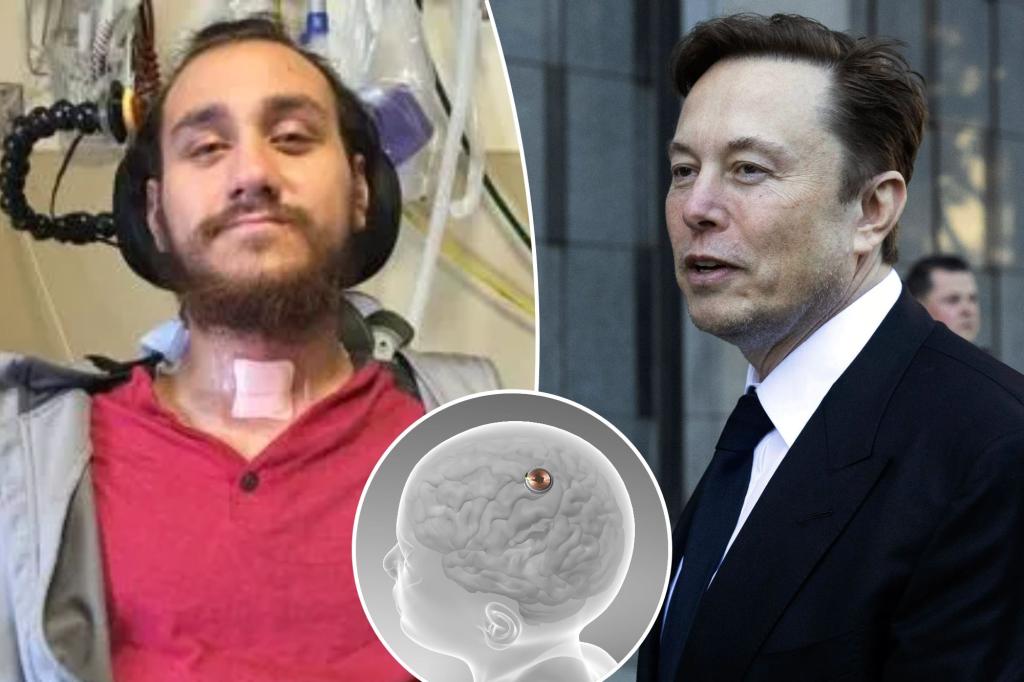Neuralink, the brain chip company co-founded by Elon Musk, is using implants that allow paralyzed people to remotely control devices with their minds — and hopes the device will one day help restore their motor functions.
The revolutionary technology relies on a coin-sized implant known as “The Link” to record and decode neural signals and then transmit the information back to the brain via electrical stimulation.
The “link” is embedded under the skull, where it receives data from neural strands that are attached to various parts of the subject’s brain, particularly those that control motor skills.
This week, the brain chip developed an unexpected problem a few months after it was placed in its first test subject, 29-year-old Noland Arbaugh, who is paralyzed from the neck down after a diving accident eight years ago.
Some of the microfilaments detached, but the company said it was able to make the implant more sensitive to improve its performance.
Each thread has sensors that can record and emit electrical currents that are “so fine and flexible that they cannot be inserted by a human hand,” according to Neuralink’s website.
The company uses a surgical robot for the delicate procedure.
The implants can also help improve memory and cognition, restore sensory, visual and motor functions and treat neurological disorders, Neuralink said.
Patient zero
In January, the company implanted The Link in Arbaugh’s brain. Last month, it was shown that it can play video games by telepathically controlling a mouse during a nine-minute live stream hosted by Neuralink.
During the video, Arbaugh explained that he just imagines the cursor going where he wants it to go and it does.
“Now I can literally just lay in bed and play to my heart’s content,” he added on the live stream in March.
failure
On Wednesday, Neuralink wrote a blog on its website stating that Arbaugh’s brain implant had experienced a problem.
“In the weeks following surgery, a number of filaments pulled away from the brain, resulting in a net reduction in the number of effective electrodes,” according to the blog post.
“In response to this change, we modified the recording algorithm to be more sensitive to neural population signals, improved the techniques for converting these signals into cursor movements, and improved the user interface,” Neuralink added, insisting the refinement will improve accuracy of Arbaugh’s ability to control cursor bits per second (BPS).
BPS, according to the company, is “the standard measure of speed and accuracy.”
The company did not specify how many strands had separated.
“Suffice it to say, this shouldn’t be happening,” Matt Engle, CEO of Paradromics, an Austin-based company developing its own device to compete with Neuralink, told WIRED.
Ricky Banerjee, chief technology officer of New York-based Synchron, which is also testing a brain-computer interface to help people with paralysis, said such failures are to be expected.
“Neuralink created a very new neural interface,” Banerjee told WIRED.
“They’re learning and that’s part of the process.”
More patients
Before Neuralink looks to make the connection available to a wider population, it must first complete its first human clinical trial, called PRIME, which is expected to last six years.
Neuralink is reportedly recruiting more eligible patients — who must be at least 18 years old, live in the U.S. or Canada, and suffer from a significant physical disability — to receive the link.
The company said selected participants will be reimbursed for costs associated with participating in the trial, including travel to and from the study site, plus the actual cost of the implant, which the EM360 technology platform reported to be about $10,500.
However, insurance is expected to raise that price to around $50,000 once the Link hits the market.
telepathy
Neuralink announced earlier this year that it had launched its “first product” – Telepathy – which “allows you to control your phone or computer, and through them almost any device, just by thinking”.
“The initial users will be those who have lost the use of their limbs,” Musk wrote to X. “Imagine if Stephen Hawking could communicate faster than a typist or an auctioneer. This is the goal.”
Musk also teased another possible brain chip feature called Blindsight that could help restore sight, in response to a video posted by another X user.



